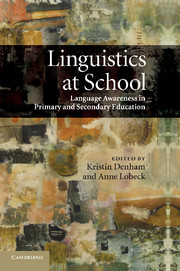Book contents
- Frontmatter
- Contents
- Notes on contributors
- Foreword: The challenge for education
- Introduction
- Part I Linguistics from the top down: encouraging institutional change
- Part II Linguistics from the bottom up: encouraging classroom change
- Part III Vignettes: voices from the classroom
- Introduction to Part III
- 16 And you can all say haboo: enriching the standard language arts curriculum with linguistic analysis
- 17 Code switching: connecting written and spoken language patterns
- 18 A primary teacher's linguistic journey
- 19 Why do VCE English Language?
- 20 Language lessons in an American middle school
- 21 The diary of Opal Whiteley: a literary and linguistic mystery
- 22 Using the Voices of North Carolina curriculum
- 23 A-level English Language teaching in London
- References
- Index
19 - Why do VCE English Language?
Published online by Cambridge University Press: 04 August 2010
- Frontmatter
- Contents
- Notes on contributors
- Foreword: The challenge for education
- Introduction
- Part I Linguistics from the top down: encouraging institutional change
- Part II Linguistics from the bottom up: encouraging classroom change
- Part III Vignettes: voices from the classroom
- Introduction to Part III
- 16 And you can all say haboo: enriching the standard language arts curriculum with linguistic analysis
- 17 Code switching: connecting written and spoken language patterns
- 18 A primary teacher's linguistic journey
- 19 Why do VCE English Language?
- 20 Language lessons in an American middle school
- 21 The diary of Opal Whiteley: a literary and linguistic mystery
- 22 Using the Voices of North Carolina curriculum
- 23 A-level English Language teaching in London
- References
- Index
Summary
Introduction
VCE (Victorian Certificate of Education) English Language (henceforth EL) was introduced into senior years at Victorian schools in Australia in 2000 as described by Jean Mulder in Chapter 5 of this book. As most teachers are likely aware, it's relatively rare for a new subject to be added to the school curriculum so it is pleasing to note that schools, teachers, and students are taking on EL in ever increasing numbers. It is a mark of the perceived relevance and popularity of the subject that the number of schools offering the Year 12 subject has expanded from 9 in 2000 to 89 in 2007. This is 17 percent of the schools which offer VCE English. All types of schools offer EL including: State, Independent, Catholic, and Adult Education.
As two teachers who have been involved in the subject since its inception, we have been excited by how quickly EL has been adopted by schools. We have been part of its development and our discussion here is a compilation of our experiences and those of many other teachers of the subject.
Why students choose English Language
It is our experience that students who are very good at English are choosing Literature and EL in Year 12, or English and EL. On the other hand, some students take EL to “escape reading,” and the dreaded “analysis of language” that is required of them in the English course.
- Type
- Chapter
- Information
- Linguistics at SchoolLanguage Awareness in Primary and Secondary Education, pp. 251 - 256Publisher: Cambridge University PressPrint publication year: 2010
- 2
- Cited by



